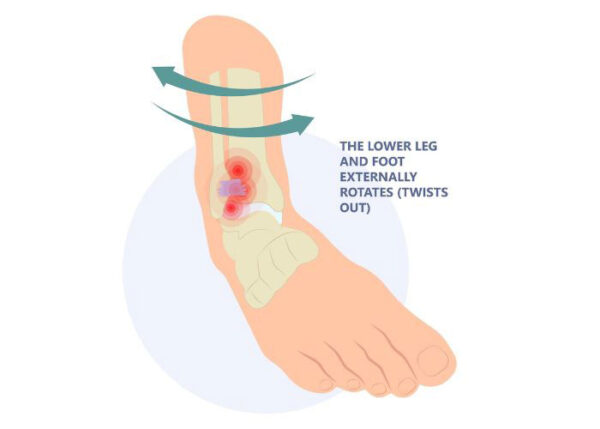Syndesmosis Rupture Specialists
Are you experiencing pain above the ankle that radiates up the leg, or pain when flexing or rotating the foot? If so, you may have a syndesmosis injury or high ankle sprain. Injuries of this nature can be difficult to diagnose, so it is important that you see our Specialists at Sport Foot and ankle, serving Vail and Frisco, Colorado, as well as Denver, Boulder, and surrounding Summit County areas. Contact The Steadman Clinic’s Sports Foot and Ankle team today!

What is a syndesmosis rupture or sprain?
A syndesmotic rupture is an ankle injury to one or more of the ligaments that connect the tibia and fibula right above the ankle. Commonly called a high ankle sprain, or rupture, the syndesmosis involves one or more of the three ligaments binding the distal tibia and fibula together. When compared to the more commonly occurring lateral ankle sprain, the high ankle sprain causes pain more proximally (just about the ankle joint). Syndesmosis ruptures or sprains can cause a greater amount of pain, and can be difficult to diagnose. It is important however to obtain a correct diagnosis because the treatment is different than with a low ankle sprain or rupture. Dr. Thomas Haytmanek and Dr. Jonathon Backus specialize in treating syndesmosis ruptures or sprains for patients from Vail and Frisco, Colorado, as well as Denver, Boulder, and surrounding Summit County areas.

What is the Anterior Inferior Tibiofibular Ligament (AITFL)?
The anterior inferior tibiofibular ligament (AITFL) is a flat, 1 centimeter wide band of fibers that connect the tibia and fibula in the ankle. It is located in the area of the ankle called the syndesmosis and is the most anterior (front) ligament within the complex. The job of the AITFL is to keep the tibia and fibula together while preventing excessive displacement of the fibula during dorsiflexion of the ankle and external rotation of the talus (ankle bone).
What is the interosseous ligament?
Also part of the syndesmosis in the ankle, the interosseous ligament – sometimes called the interosseous membrane – is located between the interosseous crests of the tibia and fibula. The job of the interosseous ligament is to help prevent widening of the tibia and fibula during loading of the leg. . This ligament or membrane is a large, thick osseofascial structure that extends from the tibial periosteum (another thin membrane on the shin bone) to the fibula: nearly the entire length between the two bones. It prevents widening but allows pistoning of the fibula a small amount during normal gait (walking).
Why are the Anterior Inferior Tibiofibular Ligament (AITFL) and the interosseous ligament important?
The anterior inferior tibiofibular ligament (AITFL) and the interosseous ligament are important for the stability of the ankle and lower extremity. These ligaments work together to statically stabilize the ankle joint. For instance, the interosseous ligament helps to keep the tibia and fibula together, and prevents the fibula from moving too much or the talus from rotating externally. At the same time, the AITFL prevents external rotation of the fibula during ankle loading.
What are the symptoms of syndesmosis rupture or sprain?
- Pain above the ankle that can radiate up the leg
- Tenderness to the touch
- Pain that increases when walking
- Trouble raising the calf
- Inability to put full weight on the ankle
- Pain when dorsiflexing the foot (bringing your toes up toward the ceiling)
- Pain when externally rotating the foot
- In chronic (long standing) injuries there can be pain and inability to cut or change direction when running
How is a syndesmosis rupture or sprain diagnosed?
Upon initial examination, syndesmosis injury is suspected when there is pain or tenderness over the syndesmosis which worsens when squeezing the tibia and fibula together (syndesmosis squeeze test) at midcalf and/or externally rotating and laterally translating the foot while supporting the knee (external rotation stress test or Cotton test). Diagnostic testing typically includes a weight bearing x-ray and often an MRI. Syndesmosis injuries can be difficult to diagnose and treat, making it extremely important to find a doctor who specializes in this type of injury like our specialists at Sports Foot and Ankle at The Steadman Clinic.
How are syndesmosis injuries graded?
Syndesmosis injuries are classified, or graded according to severity of injury:
- Grade 1: A mild sprain that involves a stretch to the ligaments. Injuries of this type are considered a stable with minimal swelling and tenderness, and little impact on function.
- Grade 2: A partial tear of one or more ligaments, which can involve the anterior inferior tibiofibular ligament (AITFL), interosseous ligament (IOL), or the deltoid ligament. This is considered an unstable injury with moderate swelling, pain, and tenderness, decreased range of motion. Ankle stability is affected and compromised.
- Grade 3: A complete tear or rupture of one or more of the ligaments, which can involve the AITFL, IOL, and posterior inferior tibiofibular ligament (PITFL), as well as deltoid ligament avulsion. Grade 3 injuries are considered severe and include significant swelling, tenderness, loss of function, and marked instability.
What is the best treatment for a syndesmosis sprain or rupture?
Non-surgical treatment:
Non-surgical treatment options can be effective for Grade 1 and some Grade 2 sprains. Conservative treatments may include:
- RICE: Rest, ice, compression, and elevation
- NSAID(s) Non-steroidal anti-inflammatory drugs
- Non-weight-bearing or CAM boot immobilization for a short period
- Physical therapy
Surgical treatment:
Some Grade 2 sprains and Grade 3 sprains require surgical intervention to restore ankle strength and function. The specialists at Sports Foot and Ankle will discuss which surgical options are best for your specific ankle injury. The treatment for a syndesmosis rupture may include:
- Reduction of the diastasis (widening) and ligament repair
- Tightrope™ Fixation
- Suture-button fixation
- AITFL augmentation
